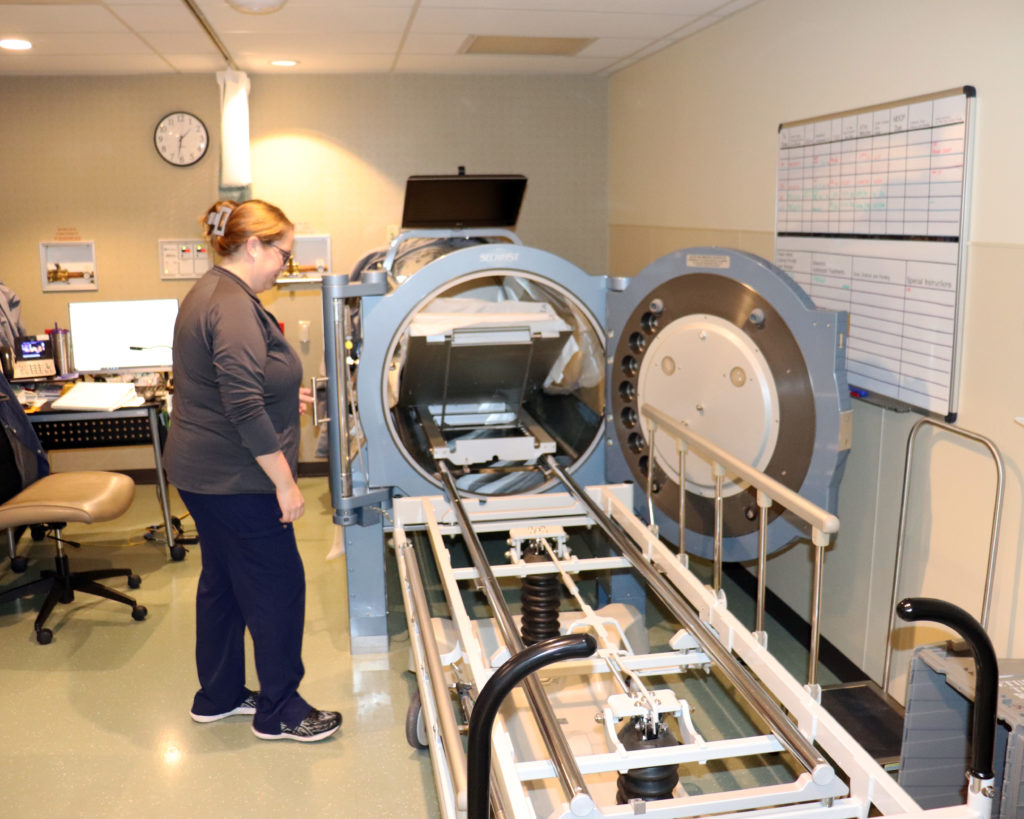
Wounds can be slow to heal for many different reasons, including, but not limited to, poor blood flow, persistent pressure, malnutrition and diabetes. The Advanced Wound Center at Western Missouri Medical Center provides highly specialized care for all types of wounds, including traumatic wounds, diabetic wounds of the lower extremities, venous stasis ulcers, pressure ulcers, non-healing surgical wounds, arterial insufficiency ulcers, atypical wounds (such as rheumatologic wounds) and other chronic wounds.
Nationally recognized by Healogics, Inc., the nation’s largest wound-care company, WMMC’s wound care center has been designated as a National Center of Distinction, receiving the Healogics President’s Circle Award in 2020 and Wound Care Center of the Year Award in 2021. We asked Dr. Diane Switzner, MD, a health care provider at the Advanced Wound Center, to discuss the innovative options available for those considering specialized wound treatment.
Wound Treatment Options
- Debridement – Dr. Switzner describes debridement as “a foundation of wound healing” and one of the primary advanced treatments used in the Advanced Wound Center. During debridement, the provider removes nonviable tissue and bacteria from the wound using a curette, scalpel and/or scissors, allowing new healthy cells to move to the wound, promoting healing.
- Hyperbaric Oxygen Chambers – A hyperbaric oxygen chamber (HBOT) is a pressurized oxygen chamber used to treat a variety of conditions. “HBOT works well for patients who have been unable to heal from the effects of radiation therapy received during cancer treatment, which can last from months to years after receiving treatment,” Dr. Switzner said. “HBOT also works well works well for osteomyelitis (infection of the bone) in conjunction with antibiotics to increase the potential of resolving the infection.”
- Diabetic Wound Treatments – The TCC-EZ offloading cast is an option for diabetic wounds on the foot. This walking cast allows wounds on the bottom of the foot to heal by relieving the pressure when walking. Compression therapy is also used to reduce swelling in the lower legs. “When a person has swelling in their legs, the elevation of their legs is very important,” Dr. Switzner said. “This can help prevent the worsening or development of wounds. Compression socks also help prevent leg swelling.”
- Advanced Treatments – Advanced skin substitutes made up of bioengineered tissues that help promote healing are available in our wound center. A variety of advanced wound dressings are available as well, including dressings that utilize silver and other antimicrobials to help decrease bacteria in the wound. For wounds with a large amount of depth or require a large amount of drainage, Dr. Switzner said that negative pressure wound therapy, also known as a “wound vac,” is an effective treatment option.
When to Seek Treatment
Dr. Switzner said patients should seek treatment if they have a wound that has not healed in 30 days. Most patients do not need a referral to be seen at the Advanced Wound Center.
However, patients with other long-term or chronic conditions, such as diabetes and lower leg edema, should seek out advanced wound care much earlier. “The most important thing to remember is to check for wounds regularly and seek treatment when they are present,” Dr. Switzner said. “Patients with diabetes can have neuropathy and have difficulty feeling when an injury has occurred, so it’s extremely important for diabetic patients to check their feet every single day.”
In addition to seeking advanced treatment options, Dr. Switzner recommends maintaining a healthy weight and blood glucose in order to promote wound healing. “Exercise helps control weight and blood glucose, and can improve blood flow,” Dr. Switzner said. “Eating a well-balanced diet, including adequate protein, is critical with wound healing. Always take medications as prescribed by your primary care provider as well.”
Contact the WMMC Advanced Wound Center
The Advanced Wound Center at Western Missouri Medical Center is located inside the hospital (403 Burkarth Road, Warrensburg, MO) on the first floor inside the Rehabilitation Services Entrance. Three different providers are available: Diane Switzner, MD; Leon Robinson, MD; and Suzanne Vogelsmeier, ANP.
If you have questions about advanced wound treatment options and if they are appropriate for you, talk to your primary care provider or call the Advanced Wound Center at (660) 262-7575.
Western Missouri Medical Center (WMMC) is a fully-accredited acute care county medical center located in Warrensburg, MO. WMMC prides itself in emergency care, obstetrics, orthopedic and general surgery, family healthcare, internal medicine, outpatient clinics, ambulatory care, rehabilitation services and more. Inpatient services include medical, surgical, intensive, obstetrical, orthopedic, pediatric and skilled nursing care, as well as a wide range of therapeutic and diagnostic outpatient services. This institution is an equal opportunity provider and employer.
Headquartered in Jacksonville, Fla., Healogics is the nation’s wound healing expert. Last year over 330,000 patients received advanced wound care through a nationwide network of nearly 700 Wound Care Centers®. The Healogics team is made up of almost 3,000 employees, 4,000 affiliated physicians and a Healogics Specialty Physician practice group of nearly 300. In addition to the company’s network of outpatient Centers, Healogics partners with over 300 skilled nursing facilities to care for patients with chronic wounds, and provides inpatient consults at more than 80 partner hospitals. As the industry leader, Healogics has the largest repository of chronic wound-specific patient data in the country. The Healogics Wound Science Initiative, an effort launched in 2017 to provide peer-reviewed research, recognizes the value and relevance of big data and advanced analytics to drive continuous, collaborative learning toward a better understanding of how to efficiently utilize healthcare resources for patients with wounds. For additional information, please visit Healogics.com.

